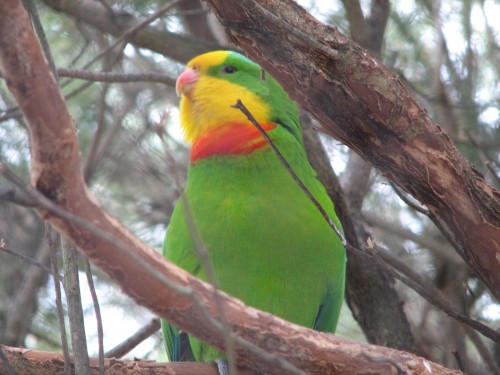Superb Parrot near Wagga Wagga
We recently travelled by road from home in Murray Bridge, South Australia (near Adelaide) to visit family in Sydney. The road trip took two days of many hours of travelling because it is a journey of over 1300km. We didn’t have many opportunities to stop and do some birding, so I had to be content with the birds seen while travelling along at highway speeds – usually 95 – 105kph. That’s not conducive to good birding practices, nor does it allow bird photography.
While travelling between Narrandera and Wagga Wagga in central west NSW I saw a solitary Superb Parrot fly across the road in front of the car. This is only the second time I’ve seen this parrot outside of an aviary. This particular area is one of the regions where this species is relatively common. It is a spectacular bird, as shown in the photo above. I cheated with this photo; it was taken of a captive bird in one of the aviaries in the Adelaide Zoo. It’s not a great photo because it was taken through the wire netting of the aviary. One day I’ll see one in the wild, one which poses perfectly for my camera.
Lower Murray Bird Club
Last night I was the guest speaker at the Lower Murray Bird Club here in Murray Bridge, South Australia. I had previously showed bird photos and spoke about Australian birds to this group about 3 years ago. Thinking that the membership is probably fairly static over a relatively short period of time, I made up a completely new talk with more recent photos to show. Just as well, because quite a few remembered my talk from back then.
I’m not into keeping birds in cages or aviaries, preferring to see my birds in the natural state. All the same, it was good to speak to a group of people who are all bird lovers, no matter where one sees them. Out of the many thousands of bird photos I could draw on for my talk, I tended to focus on those I had taken in walk-through aviaries, especially those at Adelaide Zoo.
I was made to feel most welcome and the audience was very attentive to what I had to say. I think they also enjoyed the photos I had chosen. I only wish I had a small portion of their bird knowledge, especially in the care of birds. I could be so much more helpful to my many readers if I had a broader knowledge in this field. I am trying; recently I’ve added a few more books to my growing library which will help.
People living in South Australia have many bird clubs that they could join. While many of them do not have their own websites, there is a combined site listing names, localities and contact details. The site is the United Bird Societies of South Australia (Click to access).
If you are a member of a group which might like to have me as a guest speaker, don’t hesitate to contact me through my contact form at the top of this page, or click here.
Plum-headed Parakeet, Adelaide Zoo
Australia has many beautiful parrots, some of them like the Galah are seen in flocks of hundreds and sometimes even thousands. One of our most beautiful is the usually hard to find Princess Parrot; I’ve only ever seen it in aviaries.
The Indian sub-continent can boast another truly beautiful parrot, the Plum-headed Parakeet, shown in the photos on this post. This bird was photographed late last year in a walk-through aviary at the Adelaide Zoo, a place I love to go to hone my bird photography skills. There are several walk-through aviaries, each with a good range of birds in them.
Only the male has the bright plum coloured head; the female is a duller grey. In their natural environment they are often found in forests near cultivated areas and orchards. Their preferred food includes fruit, grain and blossoms. They nest in the hollows of trees, laying 4-6 eggs. Both parents share the feeding of the young. The often roost in large, noisy communal flocks.
Further reading:
- Princess Parrot
- Large flock of Galahs
- Articles about the birds at Adelaide Zoo
Glossy Ibis, Adelaide Zoo
The Glossy Ibis is one of three species of ibis found in Australia. The others are the White Ibis and the Straw-necked Ibis. The glossy is a beautiful bird when one can get up close and see the sunlight shining on its iridescent feathers. In the natural environment it is no easy to get up so close that one can see these feathers glowing. That is why I enjoy places like the walk-through aviary at the Adelaide Zoo which is where I managed the photo above.
The Glossy Ibis has been something of a bogey bird for me. They are widespread throughout the part of South Australia where I live, yet I only saw my first one near the river at Mannum just north of home a few years ago. I have not seen another, so I need to get out birding more often.
Except for the drier parts, the Glossy Ibis is widespread throughout much of Australia where there is suitable habitat. It has a wide range of habitats, including grasslands, swamps, mangroves, wetlands, irrigated pastures, mudflats and flood plains.
Further reading:







